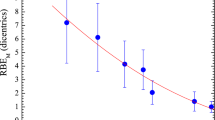Abstract
The effective dose, the personal dose equivalent, and the indications of an individual dosimeter are calculated, using the ROBOT computer program (Monte Carlo method), for the conditions of irradiation of an anthropomorphic heterogeneous ICRP phantom with wide beams of 40 keV–11 MeV photons for all solid angles. In anisotropic photon fields, the dosimeter indications satisfactorily estimate the personal dose equivalent. The dependence of the ratio of the effective dose to the indications of an individual dosimeter on the irradiation conditions is analyzed. It is noted that the individual dosimeter indications are not conservative when the phantom is irradiated from the back half-space. It is shown that for wide photon beams the ratio of the effective dose to the dosimeter indications determined neglecting the scattering of radiation inside the working room is an upper limit of the indicated ratio calculated taking scattering into account.
Similar content being viewed by others
REFERENCES
Radiation Safety. ICRP Recommendations(1990), Publication No. 60, Pt. 1; No. 61; Publication No. 60, Pt. 2 [Russian translation], Énergoatomizdat, Moscow (1994).
Radiation Safety Standards(NRB-99): Hygienic Standards, Tsentr San.-Épidem. Normirovaniya, Gigien. Sertifikatsii i Ékspertizy Minzdrava Rossii, Moscow (1999).
Conversion Coefficients for Use in Radiological Protection Against External Radiation, ICRP Publication No. 74, Pergamon Press, Oxford (1996).
Methodological Support for Radiation Monitoring at Enterprises. Vol. 1. Determination of Individual Effective and Equivalent Doses and Organization of Monitoring of Irradiation in the Work Place under Controllable Conditions for Handling Sources of Radiation. General Requirements,MU 2.6.1.016-2000, Moscow (2001).
S. O. Vyaz'min, E. V. Klass, S. F. Manakov, et al., "Status and possibility of the ROBOT system of computer programs for calculating three-dimensional protection by the Monte Carlo method," in: Abstracts of Reports at the 6th Russian Conference on Protection from Ionizing Radiation at Nuclear-Technological Facilities, September 20-23, 1994, Obninsk, pp. 106–108.
M. Cristy and K. Eckerman, Specific Absorbed Fractions of Energy at Various Ages from Internal Photons Sources, Report ORNL/TM-8381/VI (1987).
V. A. Isaev and E. V. Klass, "Effective dose in an anthropomorphic phantom under external irradiation by low-energy photons," in: Abstract of Reports at the 7th Russian Conference on Protection from Ionizing Radiation at Nuclear-Technological Facilities}, September 22-24, 1998}, Obninsk}, pp. 434–435
E. V. Klass, V. A. Rezontov, and V. V. Shakhovskii, "Some questions concerning the determination of the effective dose of external neutron irradiation," At. Énerg., 87, No. 4, 297–302 (1999).
A. A. Dubinin, A. S. Krivtsov, M. M. Savos'kin, et al., 89-Group Library of Photon Constants (BFK-89), Report FÉI No. 7835 (1990).
Author information
Authors and Affiliations
Rights and permissions
About this article
Cite this article
Klass, E.V., Shakhovskii, V.V. Relations Between the Effective Dose and the Indications of an Individual Dosimeter in Anisotropic Photon Fields. Atomic Energy 96, 267–274 (2004). https://doi.org/10.1023/B:ATEN.0000035997.47556.e0
Issue Date:
DOI: https://doi.org/10.1023/B:ATEN.0000035997.47556.e0



